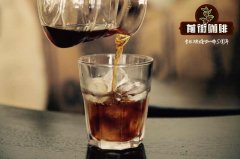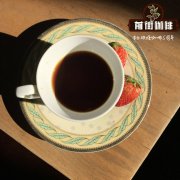Famous for its color-Huang bourbon's fascinating historical development and new bright spots

Professional coffee knowledge exchange more coffee bean information please follow the coffee workshop (Wechat official account cafe_style)
Yellow bourbon is famous for its yellow fruit at ripening stage, which is obviously different from the cherry red of other coffee varieties. Yellow bourbon has become a treasure of Brazilian coffee.
In recent years, Huang bourbon has been widely recognized by coffee buyers and roasters, partly because of its unique high-quality flavor, but also because of people's preference for different varieties of coffee for differentiation. In fact, Huang bourbon has a long and tortuous planting history and market share in Brazil.
The Origin of Yellow bourbon in Brazil
As a coffee variety, Huang bourbon has been grown on this land for nearly 90 years.
By the 1850s, Brazil had become the world's leading coffee producer. But coffee farmers at that time relied heavily on the tin card varieties introduced in the 1720s. Due to the limited production of iron pickups, this has led to a reduction in exports.
A Brazilian emissary went to the Indian Ocean island of Reunion, east of Madagascar, to obtain the seeds of the red bourbon variety. By the 1870s, Red bourbon had become a popular coffee variety in many cafes in Brazil.
But in 1871, something strange happened. According to many records, a variety of iron pickup appeared in the city of Botucatu in the state of Sao Paulo, whose fruit is yellow, which has never been seen in Brazil. Although the yield of this yellow variant (then known as yellow Botucatu) was not particularly high, it was adopted by many farmers because of the strange color of its fruit. It is worth noting that some researchers believe that yellow bourbon originated from a variation of natural red bourbon.
It is said that the first yellow bourbon first appeared in 1930 on a red bourbon farm near the city of Pederneiras (SP)-which is believed by many to be the result of natural reproduction between red bourbon and yellow Botucatu. Except for the yellow berries, this plant is very similar to red bourbon and has been shown to have the same or even higher yields.
This phenomenon attracted the attention of researchers at the Campinas Institute of Agronomy (IAC), including Carlos Arnaldo Krueger (Carlos Arnaldo Krug), who first conducted a formal study of yellow bourbon in 1942. Over the next three years, in a research field of Jau (SP), IAC planted and studied 30 pedigrees of the variety.
Throughout the 1950s, the most promising yellow bourbon varieties were given the code "IAC J" and sold to farmers. In 1951, J.E.T of the same institute. Professor Mendes studied the yields of the varieties planted at the time: iron pickup, yellow Botucatu, Sumatra, red bourbon, yellow bourbon and Marago Rippi, and the results showed that yellow bourbon had the highest yield.
But even so, Huang Bourbon never dominated the Brazilian coffee market in the decades that followed. Although it is planted commercially, it is not widely used. And because of its obvious yellow, it is often regarded as a novel plant.
In the past-in the days of Professor Krueger, Mendes and his colleagues, the quality of coffee was not a central part of plant research, which usually focused on productivity, plant health and resistance to diseases and insect pests. Along with the appearance of yellow bourbon, popular varieties such as Caturra (1937), Mundo Novo (1943) and Catua í (1949) also appeared.
However, with the rise of specialty coffee and the third wave of boutique coffee, Huang bourbon has experienced a fascinating renaissance.
But first of all, why is there yellow?
As early as 1942, fessor Krug had discovered the genetic origin of this color. It is a gene pairing called "Xanthocarpa" from the Greek xanthus (yellow) and carpus (fruit).
Plants with dominant XcXc gene pairs produce red berries; plants with recessive xcxc gene pairs produce yellow berries; and in rare cases, plants with one dominant gene and another recessive Xcxc plant produce orange berries. In the case of yellow berries, the substance expressed by these genes is luteolin, a flavonoid, also found in parsley and broccoli.
The characteristics of yellow bourbon
Huang bourbon can grow to 2.8 Michael, maturing quickly, and seven of the 30 varieties studied in 1945 were grown commercially in today's Brazil.
Because of its low and medium yield and relative sensitivity to coffee leaf rust, the cultivation of yellow bourbon may require more attention than other varieties. Huang bourbon usually shows the potential of high quality where harvesting and post-harvest processing are well performed at an altitude of more than 1000 meters.
The flavor characteristics of yellow bourbon are very obvious in the cup test, including its sweetness, rich aroma and very obvious citric acid flavor. Ripe fruits and raisins are other common flavors. Recently, researchers have found that the content of sucrose and the presence of some fatty acids and organic acids are closely related to the quality of yellow bourbon. So far, however, no significant link has been found between luteolin (the source of yellow fruit) and coffee varieties.
In 2005, IAC resumed its research on this variety and turned its attention to the flavor performance in the cup test. Again, 30 trees studied in 1945 were collected, and 16 plants with scores higher than 85 were selected to track the ideal pedigree. The team, led by Professor Gerson Giomo in IAC, are looking for plants with high productivity and high potential for cup test performance.
In 2017, Brazil's Yellow Bourbon scored 92.33 points in the Pulped Naturals category in the Excellence Cup. It sold at auction for a staggering $126.00 a pound, 100 times the price of C at the time.
Translated from Daily Coffee News
Important Notice :
前街咖啡 FrontStreet Coffee has moved to new addredd:
FrontStreet Coffee Address: 315,Donghua East Road,GuangZhou
Tel:020 38364473
- Prev

Have an important impact on taste and flavor: how to ensure the consistency of coffee fermentation processing?
Professional coffee knowledge exchange more coffee bean information please follow the coffee workshop (Wechat official account cafe_style) bread, wine, cheese, yogurt, chocolate, coffee: what do all these delicious foods have in common? That is, they all go through the process of fermentation. In coffee, fermentation is essential. It can not only remove pectin, but also improve the taste and taste.
- Next

The biggest difference between Ole coffee and latte is the way the milk is heated.
Professional coffee knowledge exchange more coffee bean information Please pay attention to the coffee workshop (Wechat official account cafe_style) Italian lattes (Caffe Latte) requires a small cup of Espresso and a cup of milk (150mm 200ml), lattes contain more milk but less coffee, which is very different from Cappuccino. The latte is extremely simple. It's just made.
Related
- Beginners will see the "Coffee pull flower" guide!
- What is the difference between ice blog purified milk and ordinary milk coffee?
- Why is the Philippines the largest producer of crops in Liberia?
- For coffee extraction, should the fine powder be retained?
- How does extracted espresso fill pressed powder? How much strength does it take to press the powder?
- How to make jasmine cold extract coffee? Is the jasmine + latte good?
- Will this little toy really make the coffee taste better? How does Lily Drip affect coffee extraction?
- Will the action of slapping the filter cup also affect coffee extraction?
- What's the difference between powder-to-water ratio and powder-to-liquid ratio?
- What is the Ethiopian local species? What does it have to do with Heirloom native species?

